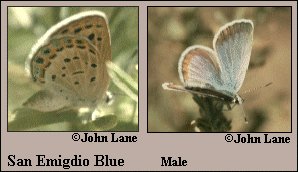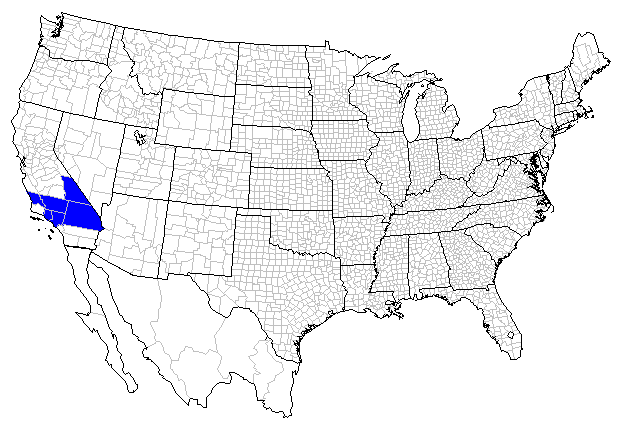 |
 

 |



San Emigdio Blue (Plebeius emigdionis [Grinnell])
Wing span: 7/8 - 1 1/8 inches (2.2 - 2.9 cm).
Identification: Upperside of male pale blue with wide brown border; hindwing with faint orange band at outer margin. Female brown with blue at wing bases and orange bands near outer margins. Underside of both sexes white with many small black spots; forewing postmedian band has 2 elongated spots.
Life history: Eggs are laid singly on leaves of the host plant. Caterpillars eat leaves and are tended by ants. Older caterpillars hibernate.
Flight: Three flights from April-September.
Caterpillar hosts: Shadscale (Atriplex canescens) in the goosefoot family (Chenopodiaceae).
Adult food: Not reported.
Habitat: Shadscale scrub in desert canyons and near washes.
Range: Very local in southern California from Inyo County south through the Mojave Desert, San Joaquin Valley, Bouquet and Mint Canyons, and Los Angeles County.
Conservation: Habitat of all populations should be monitored or conserved.
The Nature Conservancy Global Rank: G3 - Very rare or local throughout its range or found locally in a restricted range (21 to 100 occurrences). (Threatened throughout its range).
Management needs: Maintain habitat and protect from non-indigenous plants.
References:
Scott, J. A. 1986. The butterflies of North America. Stanford University Press,
Stanford, Calif. 583 pages, 64 color plates.
Tilden, J. W. 1986. A field guide to western butterflies. Houghton-Mifflin Co.,
Boston, Mass. 370 pages, 23 color plates.
Author: Jane M. Struttmann

